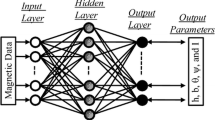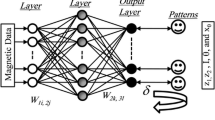Abstract
A new approach is proposed to interpret magnetic anomalies caused by isolated thin dike-like causative targets. The approach is essentially based on utilizing artificial neural network (ANN) inversion for estimating the problem parameters. Particularly, the modular neural network (MNN) is used for the inversion process in order to quantitatively interpret the magnetic anomalies. The MNN inversion has been first tested on a synthetic data with and without random white Gaussian noise. The effect of random noise has been clearly investigated where it showed that the approach provided satisfactory results. Furthermore, three field examples have been inverted in order to investigate the applicability of the proposed approach. The results showed good agreement with the techniques that have been stated in the literatures.











Similar content being viewed by others
References
Abdelrahman EM (1994) A rapid approach to depth determination from magnetic anomalies due to simple geometrical bodies. J Univ of Kuwait (Science) 21:109–115
Abdelrahman EM, Abo-Ezz ER, Essa KS (2012) Parametric inversion of residual magnetic anomalies due to simple geometric bodies. Explor Geophys 43:178–189
Abdelrahman EM, Abo-Ezz ER, Soliman S, El-Araby TM, Essa KS (2007) A least-squares window curves method for interpretation of magnetic anomalies caused by dipping dikes. Pure Appl Geophys 164:1027–1044
Abdelrahman EM, Essa KS (2015) A new method for depth and shape determinations from magnetic data. Pure Appl Geophys 172:439–460
Abdelrahman EM, Sharafeldin SM (1996) An iterative least-squares approach to depth determination from residual magnetic anomalies due to thin dikes. Appl Geophs 34:213–220
Abdelrahman EM, Soliman S, Abo-Ezz ER, El-Araby TM, Essa KS (2009) A least-squares standard deviation method to interpret magnetic anomalies due to thin dikes. Near Surf Geophys 7:41–46
Al-Chalabi M (1971) Some studies relating to non-uniqueness in gravity and magnetic inverse problems. Geophysics 36(5):835–855
Al-Chalabi M (1972) Interpretation of gravity anomalies by non-linear optimization. Geophys Prospect 10:1–15
Al-Chalabi M (1970) Interpretation of two-dimensional magnetic profiles by non-linear optimization. Bolletino Di Geofisica Teorica Ed Applicata 12:3–20
Al-Garni MA (2010) Interpretation of spontaneous potential anomalies from some simple geometrically shaped bodies using neural network inversion. Acta Geophysica 58:143–162
Am K (1972) The arbitrary magnetized dike; interpretation by characteristics. Geoexploration 10:63–90
Asfahani J, Tlas M (2007) A robust nonlinear inversion for interpretation of magnetic anomalies caused by faults, thin dikes and spheres like structure using stochastic algorithms. Pure Appl Geophys 164:2023–2042
Asfahani J, Tlas M (2004) Nonlinearly constrained optimization theory to interpret magnetic anomalies due to vertical faults and thin dikes. Pure Appl Geophys 161:203–219
Atchuta Rao D, Ram Babu HV, Sankar Narayan PV (1980) Relationship of magnetic anpmalies due to subsurface features and interpretation of solving contacts. Geophys 45:32–36
Atchuta Rao D, Ram Babu HV (1983) Standard curves for the interpretation of magnetic anomalies over vertical faults. Geophy Res Bull 21:71–89
Azam F (2000) Biologically inspired modular neural networks PhD Dissertation, the Virginia Polytechnic Institute and State University
Bean RJ (1966) A rapid graphical solution for the aeromagnetic anomaly of the two-dimensional tabular body. Geophysics 31:963–970
Bescoby DJ, Cawley GC, Chroston PN (2006) Enhanced interpretation of magnetic survey data from archaeological sites using artificial neural networks. Geophysics 71:H45–H53
Bhatt A, Helle H (2002) Committee neural network for porosity and permeability prediction from well logs. Geophys Prospect 50:645–660
Bhattacharyya BK (1965) Two-dimensional harmonic analysis as a tool for magnetic interpretation. Geophys 30:829–857
Bishop CM (1995a) Training with noise is equivalent to Tikhonov regularization. Neural Comp 7(1):108-116
Bishop CM (1995b) Neural networks for pattern recognition. Oxford University Press, Oxford, p 482
Bruckshaw JM, Kunaratnam K (1963) The interpretation of magnetic anomalies due to dikes. Geophys Prosp 11:519–522
Ekinci YL (2016) Matlab-based algorithm to estimate depths of isolated thin dike-like sources using higher-order horizontal derivatives of magnetic anomalies. SpringerPlus 5:1384
El-Araby HM (2003) Quantitative interpretation of numerical horizontal magnetic gradients over dipping dikes. Bull Fac Sci Cairo Univ 71:97–121
El-Kaliouby H (2001) Extracting IP parameters from TEM data. Chapter 17 in M.M. Poulton (ed.), Computational neural networks for geophysical data processing: Pergamon Press, Inc
El-Kaliouby H, Poulton M (1999) Inversion of coincident loop TEM data for layered polarizabe ground using neural networks. Society of Exploration Geophysicists (SEG) 69th annual meeting. Houston, Texas, USA
El-Kaliouby HM, Al-Garni MA (2009) Inversion of self-potential anomalies caused by 2D inclined sheets using neural networks. J Geophys Eng 6:29–34
El-Qady G, Ushijima K (2001) Inversion of DC resistivity data using neural networks. Geophys Prospect 49:417–430
Fossati M, Zerilli A, Ronchini G, Apollono B (1992) Lineament analysis for potential field data using neural network: 62nd Annual International Meeting. SEG, Expanded Abstracts, pp 6–9
Gay SP (1963) Standard curves for interpretation of magnetic anomalies over long tabular bodies. Geophysics 28:161–200
Gay SP (1965) Standard curves for the interpretation of magnetic anomalies over long horizontal cylinders. Geophysics 30:818–828
Grant FS, Martin L (1966) Interpretation of aeromagnetic anomalies by the use of characteristic curves. Geophysics 31:135–148
Grant FS, West GF (1965) Interpretation theory in applied geophysics. Mc Graw Hill Book Co., New York
Haykin S (1994) Neural networks: a comprehensive foundation. Macmillan Publication Co.
Helle HB, Bhatt A, Ursin B (2001) Porosity and permeability prediction from wireline logs using artificial neural networks: a North Sea case study. Geophys Prospect 49:431–444
High JE, Smith MJ (1975) Standard curves for interpretation of magnetic anomalies due to thin dikes of finite depth extent. Australian Govt. Pub. Ser, Canberra
Hjelt SE (1973) Experiences with automatic magnetic interpretation using the thick plate model. Geophys Prospect 21:243–265
Hjelt SE (1975) Performance comparison of non-linear optimization methods applied to interpretation in magnetic prospecting. Geophysica 13:144–166
Jacobs RA, Jordan MA, Nowlan SJ, Hinton GE (1991) Adaptive mixtures of local experts. Neural Comput 3:79-87
Jain LC, Martin NM (1999) Fusion of neural networks, fuzzy sets and genetic algorithms: industrial applications. CRC Press
Jang JSR, Sun CT, Mizutani E (1997) Neuro-fuzzy and soft computing: a computational approach to learning and machine intelligence. Prentice-Hall, Inc
Koulomzine T, Lamontagn Y, Nadeau A (1970) New methods for the direct interpretation of magnetic anomalies caused by inclined dikes of infinite length. Geophysics 35:812–830
Li X (2003) On the uses of different methods for estimating magnetic depth. The leading Edge: 1090-1099
Lynch E, Jonberger J (2014) Summary report on available geological, geochemical and geophysical information for the Nautanen key area, Norrbotten. Geological Survey of Sweden report no 34
Macias C, Sen M, Stoffa P (2000) Artificial neural networks for parameter estimation in geophysics. Geophys Prospect 48:21–47
Masters T (1993) Practical neural network recipes in C++. Academic Press, Inc
Matera F (1998) Modular neural network. Substance use & misuse 33:307–315
McGrath PH, Hood PJ (1970) The dipping dike case, a computer curve matching method of magnetic interpretation. Geophysics 35:831–848
Mohan NL, Sundararajan N, Rao S (1982) Interpretation of some two-dimensional magnetic bodies using Hilbert transforms. Geophys 46:376–387
Moo JKC (1965) Analytic aeromagnetic interpretation the inclined prism. Geophys Prosp 13:203–224
Prakasa Rao TKS, Subrahmanyan M, Srikrishna Murthy A (1986) Nomograms for direct interpretation of magnetic anomalies due to long horizontal cylinders. Geophys 51:2150-2159
Prakasa Rao TKS, Krishna Murthy AS (1978) Interpretation of magnetic anomalies caused by dykes using characteristic curves. Andhra University, Waltair, Janyary, A.E.G. Seminar, pp 19-21
Paul MK, Datta S, Banerjee B (1966) Direct interpretation of two-dimensional structural faults from gravity data. Geophysics 31(5):940–948
Poulton MM (2001) Computational neural networks for geophysical data processing. Pergamon Press, Inc
Poulton MM (2002) Neural networks as an intelligence amplification tool: a review of applications. Geophysics 67:979–993
Poulton MM, Sternberg BK, Glass CE (1992a) Location of subsurface targets in geophysical data using neural networks. Geophysics 57:1534–1544
Poulton MM, Sternberg BK, Glass CE (1992b) Neural network pattern recognition of subsurface EM images. J Appl Geophys 29:21–36
Powell DW (1965) A rapid method of determining dip or magnetization, inclination from magnetic anomalies due to dike-like bodies. Geophys Prosp 13:197–202
Powell DW (1967) Fitting observed profiles to a magnetized dike or fault-step-model. Geophys Prosp 15:208–220
Radhakrishna Murthy IV (1985) The mid-point method: magnetic interpretation of dykes and faults. Geophysics 50(5):834–839
Radhakrishna Murthy IV (1990) Magnetic anomalies of two-dimensional bodies and algorithm for magnetic inversion of dykes and basement topographies. Proc Indian Acad Sci (Earth and Planetary Sciences) 99(4):549–579
Radhakrishna Murthy IV, Visweswara Rao C, Gopala-krishna G (1980) A gradient method for interpreting magnetic anomalies due to horizontal circular cylinders, infinite dykes and vertical steps. Proc Indian Acad Sci (Earth and Planetary Sciences) 89(1):31–42
Raiche A (1991) A pattern recognition approach to geophysical inversion using neural nets. Geophys J Int 105:629–648
Rama Rao C, Veeraswamy K, Sarma MRL, Baskara Rao DS (1987) Interpretation of magnetic anomalies due to infinite dyke and vertical steps using relation figures. Geophys Res Bull 25(4):178–183
Rao BSR, Murthy IVR (1978) Gravity and magnetic methods of prospecting. Arnold Heinmann, New Delhi
Salem A (2005) Interpretation of magnetic data using analytic signal derivations. Geophys Prospecting 53:75–82
Salem A, Ravat D (2003) A combined analytic signal and Euler method (AN-EUL) for automatic interpretation of magnetic data. Geophys 68:1952–1961
Salem A, Ravat D, Mushayandebvu MF, Ushijima K (2004) Linearized least-squares method for interpretation of potential-field data from sources of simple geometry. Geophys 69:783–788
Salem A, Smith R (2005) Depth and structural index from normalized local wavenumber of 2D magnetic anomalies. Geophys Prospecting 53:83–89
Shafiqullah M, Langlois JD (1978) The Pima mining district Arizona: a geochronologic update. In: New Mexico Geological Society Guidebook 29th field conference. pp 321-327
Silva JBC (1989) Transformation of nonlinear problems into linear ones applied to the magnetic field of a two-dimensional prism. Geophys 54:114–121
Smellie DW (1956) Elementray approximation in aero-magnetic interpretation. Geophysics 21:1021–1040
Spichak V, Popova I (2000) Artificial neural networkinversion of magnetotelluric data in terms of three-dimensional earth macrparameters. Geophys J Int 142:15–26
Srinivas Y, Stanley Raj A, Hudson Oliver D, Muthuraj D, Chandrasekar N (2012) A robust behavior of Feed Forward Back propagation algorithm of Artificial Neural Networks in the application of vertical electrical sounding data inversion. Geosci Front 3:729–736
Stanley RA, Srinivas Y, Hudson Oliver D, Muthuraj D (2014) A novel and generalized approach in the inversion of geoelectrical resistivity data using Artificial Neural Networks (ANN). J Earth Syst Sci 123:395–411
Stanley JM, Green R (1976) Gravity gradients and the interpretation of the truncated plate. Geophysics 41:1370–1376
Sundararajan N, Mohan NL, Vijaya Raghava MS, Rao S (1985) Hilbert transform in the interpretation of magnetic anomalies of various components due to thin infinite dike. Pure Appl Geophys 123:557–566
Telford WM, Geldart LP, Sheriff RA, Keys DA (1976) Applied geophysics. Cambridge University press, Cambridge
Tlas M, Asfahani J (2011a) Fair function minimization for interpretion of magnetic anomalies due to thin dikes, spheres and faults. J Appl Geophys 75:237–243
Tlas M, Asfahani J (2011b) A new best-estimate methodology for determining magnetic parameters related to field anomalies produced by buried thin dikes and horizontal cylinder-like structures. Pure Appl Geophys 168:861–870
Ucan ON, Bilgili E, Albora AM (2002) Magnetic anomaly separation using genetic cellular neural networks. J Balkan Geophys Soc 5:65–70
Van der Baan M, Jutten C (2000) Neural networks in geophysical applications. Geophysics 65:1032–1047
Williams PM (1995) Bayesian regularization and pruning using a Laplace prior. Neural Comp 7(1):117–143
Won IJ (1981) Application of Gauss’s method to magnetic anomalies of dipping dykes. Geophysics 46:211–215
Yarger HL, Robertson RR, Wentland RL (1978) Diurnal drift removal from aeromagnetic data using least squares. Geophysics 46:1148–1156
Zhang L, Poulton MM, Wang T (2002) Borehole electrical resistivity modeling using neural networks. Geophysics 67:1790–1797
Zhang Q, Gupta K (2000) Neural networks for RF and microwave design. Artech House Inc.
Author information
Authors and Affiliations
Corresponding author
Rights and permissions
About this article
Cite this article
Al-Garni, M.A. Inversion of magnetic anomalies due to isolated thin dike-like sources using artificial neural networks. Arab J Geosci 10, 337 (2017). https://doi.org/10.1007/s12517-017-3115-9
Received:
Accepted:
Published:
DOI: https://doi.org/10.1007/s12517-017-3115-9




